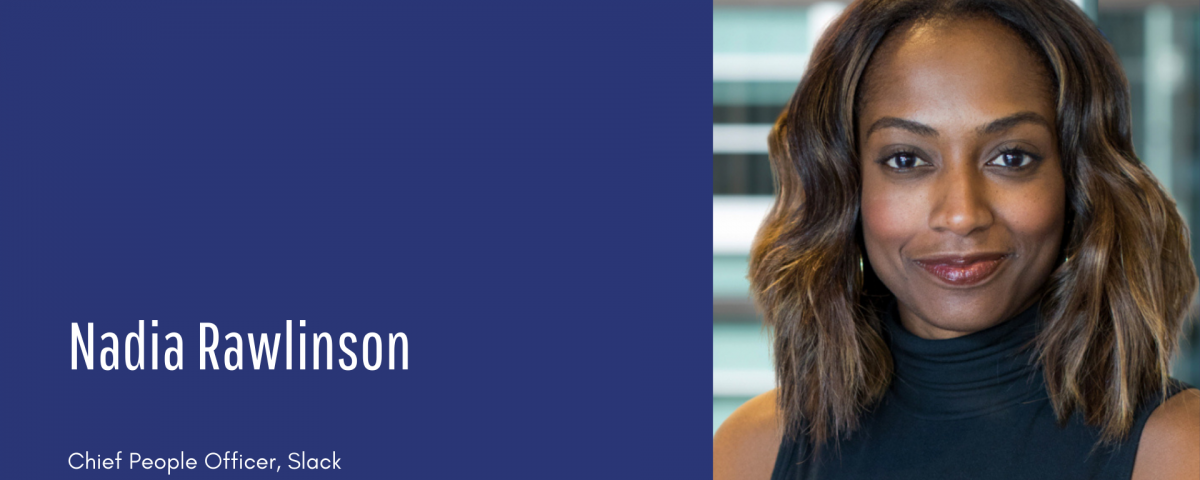- Have any questions?
- 888-432-8878
- steve@sebackground.com
While much needs to be done to neutralize our biases and unleash untapped talent – Nadia Rawlinson, Chief Purpose Officer of Slack, is already hard at work developing the one asset she feels will help ensure deep-level diversity and inclusion throughout the organization. In recent years, Rawlinson has worked alongside some of the biggest names in the technology industry to advance diversity and inclusion in the workplace. It’s an ambitious and inspiring initiative.

The HR Digest: You’ve been at Slack for seven months. What were your first impressions of Slack’s company culture? How will you influence that culture in your new role?
Nadia Rawlinson: Since joining the company in September, I have been struck by the warmth, humility, intelligence and true “humanness” everyone brings to work each day. I’ve marveled at our employees’ commitment to showing up and delivering for our customers, and each other, no matter what. This attitude permeates every interaction I’ve had, and it is truly unique in the current world of work – but I also believe that it doesn’t have to be.
What I was most impressed by, however, is how strongly I could feel this culture and sense of community right out of the gate, despite being onboarded in a fully remote environment—and a lot of that has to do with our product. At the most basic level, the casual nature of messaging on Slack makes it conducive to short, friendly exchanges that more closely mirror the in-person conversations that take place in the office. It has been really impactful in helping me really get to know and get comfortable with my team members, both professionally and personally.
Looking ahead, I think what I am most focused on is working out how to best keep that sense of culture and inclusivity going as we get deeper into remote work and onboard more and more employees remotely. Now more than ever, employees are expecting their companies to be more intentional in their efforts to build an inclusive internal culture that supports employees’ “full selves”—and figuring out how to best foster that culture outside of the office is an opportunity I’m looking forward to.
We understand Slack’s team is growing at a rapid pace. What will hiring look like in the coming year? When you set out to recruit new talent, what do you look for?
Our hiring policies have changed permanently as we transition into being a much more distributed company, and they will continue to evolve as we navigate this new frontier of remote and hybrid work. Hiring for a distributed workforce brings some considerable advantages—most notably in building more diverse teams. It shifts the center of connection, innovation and power away from the company’s physical HQ, and provides an opportunity to move past norms and build more inclusive and diverse teams from a wide range of geographies outside of the areas immediately surrounding your physical offices.
Different backgrounds mean different learning styles, different means of problem-solving, and different perspectives on solutions. With regard to recruiting new talent, it can be easy to fall into the trap of looking for people who “check” certain boxes. But in my career, I have found so much value in the unexpected. I believe that every unconventional choice you make – whether that’s taking a job overseas, or at a company no one has heard of, or in an industry people aren’t familiar with — gives you a unique experience that ultimately pays off in spades and increases the value you bring to a role.
While I’ve always liked to look for candidates who have made unconventional choices in their careers, hiring a distributed workforce opens up even more opportunities to source the unexpected talent you may not have encountered otherwise.
Do you think that post-pandemic trends like remote working, flexi hours become a common trend? What other trends at work, do you think are here to stay?
I do believe the new ways of working and living that have emerged during this period will persist in the post-pandemic world. A recent survey conducted by Future Forum, a consortium launched by Slack to help companies reimagine work in the new digital-first world, found that the vast majority (83%) of knowledge workers [in the U.S., the U.K., France, Germany, Japan and Australia] do not want to return to five days a week in an office. And after a year of remote work, I think organizations have come to realize that employees can be just as—if not more—engaged and productive when working from home. Giving people the flexibility to work when it works for them, with the autonomy and tools needed to support that will become table stakes.
However, staying fully remote may not work for everyone, and one emerging trend I think is likely here to stay is the hybrid/remote office model—i.e., allowing employees to work remote a few days a week and be in the office a few days a week. It provides employees the flexibility they have come to expect, while also catering to those who are accustomed to and prefer work in physical offices from time to time. Beyond that, it’s tough to predict exactly what the future looks like, and I expect companies will adopt their own unique policies adapted to their specific industries and employees’ needs. However, one thing is for sure—as we enter these uncharted waters, staying innovative and competitive will require organizations to be agile and willing to break old habits, build new approaches to work and evolve their cultures. Those who don’t are likely to leave their employees searching for greener pastures.
To make a success of digital transformation, effective leadership and mature organizational culture is required. What is the mindset that leaders require in order to succeed in a digital world?
I firmly believe that the best way to build a strong organization is to meet people where they are. Leaders who want to prioritize humanity at work—meaning authentic, open, transparent interaction— can help by exhibiting behaviors, tools and actions that encourage inclusivity, flexibility, and connectedness. Especially as we transition into the new normal in a post-pandemic world, my advice for leaders is to over-communicate, put your words into actions, and codify cultural changes.
Over-communicate: Communicate transparently and authentically to employees, even to the point of where you may feel you’re repeating yourself. In anxious times, employees will fill a perceived vacuum and often jump to worst-case scenarios. Even when you don’t have perfect or complete information, communicating and being open about those unknowns helps build trust and confidence with your teams.
Put your words into actions: Any change to how people work must be not only supported by the highest levels of leadership, but also demonstrated by those same leaders. For example, when leaders encourage their employees to take time for themselves, employees are much more likely to do so when those same leaders are taking time as well.
Codify structural and policy changes: For employees to understand and be confident in a new way of working, those new rules need to be reflected in your company’s official policies. It’s one thing to hear “we’re giving employees 80 hours of Emergency Time Off” and another to go into Workday and see you have a drop-down menu offering ETO as an option alongside more familiar terms and leaders making use of that themselves.
One of the big themes in your work is increasing the importance of an underrepresented workforce. What’s your sense of what companies can do to build, manage and promote workplace diversity?
In the wake of this past year’s events and the ongoing national and global reckoning with racial and social inequality, it has become clear that diversity training is no longer enough. To ensure adequate progress is being made, detailed strategic plans need to be implemented to drive and measure long-term diversity, equity and inclusion initiatives. Here at Slack, we take a holistic approach to building an inclusive and diverse company and culture—from recruiting out of a broad and diverse pool of talent, to training managers how to build trust with their teams and manage inclusively, to co-creating a culture of safety, trust and empowered voices.
As a part of our commitment to embed diversity, engagement and belonging in our hiring practices and workplace culture, every year we release a company diversity report. We see the annual report as an opportunity to step back and critically evaluate whether our approaches are having the desired impact. If they aren’t, we take what we learn from the data and use it to develop new programs and improve existing ones. If we don’t take the opportunity to step back and take a hard look at whether our systems are working—whether we’re making actual progress—then we will fail the communities we’ve committed to serving and lose the opportunity to truly make lasting change.
The post Diversity As Strategy: An Interview with Nadia Rawlinson appeared first on The HR Digest.
Source: New feed






